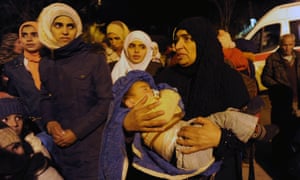Link
These were harrowing images, ones that bring to mind horrors seen during the second world war. Emaciated children, bones visible beneath their skin, their feeble voices begging for food. The skeletal body of a man who starved to death. The stories behind these images were no less heart-wrenching: families reduced to eating grass and leaves, parents eating nothing at all so their children might survive.
These were not scenes from a medieval history book, nor from a country stricken by natural disaster, but from today’s Syria, a country where the list of atrocities inflicted on civilians seems to have no end. The plight of Madaya – just an hour from Damascus – a town of 30,000 besieged since July last year, was suddenly brought to the world’s attention by Syrian activists and opposition networks who resorted to spreading photos and videos online. They did well: a first convoy of United Nations aid finally arrived earlier this week. A second one got through on Thursday. UN officials and international aid workers found at least 400 inhabitants in a critical state of undernourishment. According to Médecins Sans Frontières, at least 28 people, including six babies, had succumbed to famine.
The age-old strategy of siege is back. The Syrian regime, aided by Iranian-controlled foot soldiers, had chosen this method to retake charge of key routes connecting Damascus to the Lebanese border and coastal areas. It was a policy of starve-or-surrender, in a blatant violation of international humanitarian law. That this crime – which must now be thoroughly documented by the UN commission investigating atrocities in Syria – even happened is terrible. That it took so long for public opinion and international actors to become aware of it adds to the scandal. This was both a humanitarian blockade and a media blockade, typical of the Assad regime, where journalists are routinely kidnapped. Without the international outrage, it is hard to judge when a reluctant Syrian government would have lifted the siege of the rebel-held town.
But it would be short-sighted to see this as a definitive or even a sufficient outcome. Indeed, both the Assad regime and its Hezbollah allies have claimed to have had nothing to do with the starvation. Nor is it any less worrying that the siege stopped only after the UN negotiated a tit-for-tat agreement whereby aid would be allowed through to two northern areas, encircled by anti-Assad rebels.
Madaya is not an exception. The UN estimates that at least 15 other Syrian towns are currently besieged, with more than 400,000 people denied access to food and medicine. Almost two years after a UN resolution that supposedly forced warring parties to let aid through, the situation seems only to have worsened. The number of Syrians deemed “at risk” has doubled, says the UN. Saving Madaya should blind no one to the fact that atrocities against civilians are ongoing, even intensifying, and that the Assad regime and its allies are overwhelmingly to blame.
For now, the priority is to get aid through. But it is essential not to lose sight of the need ultimately to hold those responsible for these crimes to account. There is a terrible list of horror and brutality. And when, one day, peace finally comes, the perpetrators must not be forgotten.


No comments:
Post a Comment